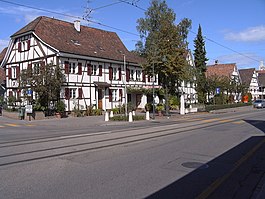Allschwil
| Allschwil | ||
|---|---|---|

Allschwil village
|
||
|
||
| Coordinates: 47°33′N 7°32′E / 47.550°N 7.533°ECoordinates: 47°33′N 7°32′E / 47.550°N 7.533°E | ||
| Country | Switzerland | |
| Canton | Basel-Landschaft | |
| District | Arlesheim | |
| Government | ||
| • Executive |
Gemeinderat with 7 members |
|
| • Mayor |
Gemeindepräsident/in Nicole Nüssli-Kaiser FDP/PRD |
|
| • Parliament |
Einwohnerrat with 40 members |
|
| Area | ||
| • Total | 8.92 km2 (3.44 sq mi) | |
| Elevation (Dorfplatz) | 285 m (935 ft) | |
| Population (Mar 2016) | ||
| • Total | 20,536 | |
| • Density | 2,300/km2 (6,000/sq mi) | |
| Demonym(s) | German: Allschwiler(in) | |
| Postal code | 4123 | |
| SFOS number | 2762 | |
| Localities | Neuallschwil | |
| Surrounded by | Baselland (BL), Binningen, Buschwiller (FR-68), Hégenheim (FR-68), Neuwiller (FR-68), Oberwil, Saint-Louis (FR-68), Schönenbuch | |
| Twin towns | Pfullendorf (Germany), Blaj (Romania) | |
| Website |
www SFSO statistics |
|
Allschwil (German pronunciation: [ˈalʃvil]) is a statistic town and a municipality in the district of Arlesheim in the canton of Basel-Country in Switzerland.
Allschwil is a seamless suburb of Basel and is located between Basel to the east and Alsace in France to the west.
The official language of Allschwil is (the Swiss variety of Standard) German, but the main spoken language is the local variant of the Alemannic Swiss German dialect.
The modern municipality of Allschwil is first mentioned in 1118 as Almswilre.
The region around Allschwil has been occupied since at least the Middle Paleolithic. Archeological finds from the municipality include a few scattered Middle Paleolithic items, cups from the Glockenbecherkultur (c. 2400–1800 BC), a mid-Bronze Age hoard (presumably a metal depot) and a Hallstatt culture settlement at in den Vogelgärten. In 1937, at New-Allschwil, a Gallo-Roman cremation cemetery (from c. AD 25–60) was discovered. It is one of the oldest in northern Switzerland. It is possible that the Roman road station Arialbinum (mentioned in "Antonine Itinerary" and "Tabula Peutingeriana") may correspond to Allschwil.
Allschwil was part of the Herrschaft of Birseck, which was given in 1004 as an imperial donation to the Bishop of Basel. Through the middle of the 15th century the Herrschaft was often pawned and sold. The town of Allschwil was located along the Alsace-Solothurn via Passwang pass trading route along the border. Its location on the border and trade route allowed Allschwil to grow into an important customs facility. After 1724 it housed the northern salt warehouse of the vogtei of the diocese of Basel. Allschwil was one of the seven so-called free villages (Vagantes extra civitate Basiliensem) and was therefore under the parish of St. John's Chapel at Basel's cathedral for baptism and high church festivals.
...
Wikipedia



